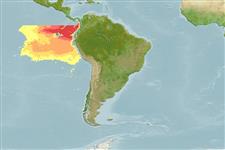Elasmobranchii (tubarões e raias) (sharks and rays) >
Carcharhiniformes (Ground sharks) >
Pentanchidae (Deepwater catsharks)
Etymology: Bythaelurus: bythos (Gr.), depths of the sea, referring to its deepwater habitat; ailouros (Gr.), cat, probably an allusion to the vernacular “catshark,” so named for its cat-like eyes. (See ETYFish); giddingsi: In honor of Al Giddings (b. 1937), American underwater filmmaker, naturalist, and friend. (See ETYFish).
More on authors: McCosker, Long & Baldwin.
Environment: milieu / climate zone / depth range / distribution range
Ecologia
marinhas batipelágico; intervalo de profundidade 428 - 562 m (Ref. 89625). Tropical
Pacific Ocean: presumed to be endemic to the Galápagos Islands.
Tamanho / Peso / Idade
Maturity: Lm ? range ? - ? cm
Max length : 45.3 cm TL macho/indeterminado; (Ref. 89625)
Descrição suscinta
Chaves de identificação | Morfologia | Morfometria
This species is moderately sized and have the following characters: snout bluntly rounded;
preoral length 4.7-6.8% TL; short head, length about equal to pectoral-pelvic space, 21-24% TL; precaudal length 73-80% TL; dorsal and anal fins are subequal; length of anal-fin base about equal to length of interdorsal space; 81-85 (mean = 82.6) precaudal vertebrae; color chocolate brown dorsally, paler on ventral surface from snout to anus; body, flanks, caudal and median fins are overlain with pale spots about equal in size to eye, becoming smaller below lateral midline, and showing a bilaterally asymmetrical pattern. It differs from its congeners in its coloration, the length of its anal-fin base, and in other morphological characters (Ref. 89625).
This species were observed living on the bottom above sand or sand and mud substrates,
in the vicinity of lava boulders, either over flat bottoms or along slopes to 45° (Ref. 89625).
Ciclo de vida ou comportamento de acasalamento
Maturities | Reprodução | Spawnings | Egg(s) | Fecundities | Larvas
McCosker, J.E., D.J. Long and C.C. Baldwin, 2012. Description of a new species of deepwater catshark, Bythaelurus giddingsi sp. nov., from the Galápagos Islands (Chondrichthyes: Carcharhiniformes: Scyliorhinidae). Zootaxa 3221:48-59. (Ref. 89625)
Status na Lista Vermelha da UICN (Ref. 130435)
Ameaça para os humanos
Harmless
Uso pelos humanos
Ferramentas
Relatórios especiais
Baixar XML
Fontes da internet
Estimates based on models
Preferred temperature (Ref.
123201): 2.6 - 3.3, mean 3.1 °C (based on 9 cells).
Índice de diversidade filogenética (Ref.
82804): PD
50 = 0.5001 [Uniqueness, from 0.5 = low to 2.0 = high].
Bayesian length-weight: a=0.00355 (0.00176 - 0.00714), b=3.09 (2.91 - 3.27), in cm total length, based on LWR estimates for this (Sub)family-body shape (Ref.
93245).
Nível Trófico (Ref.
69278): 4.3 ±0.5 se; based on size and trophs of closest relatives
Fishing Vulnerability (Ref.
59153): Moderate vulnerability (35 of 100).
